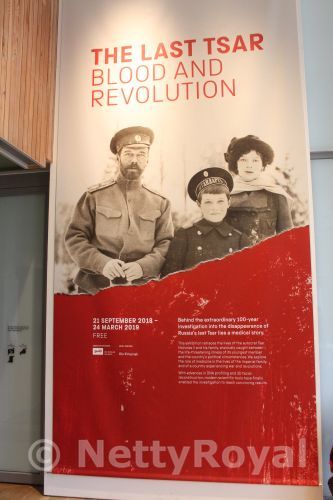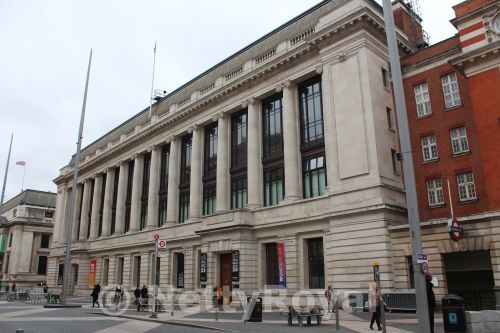 Today will be the last day the exhibition “The Last Tsar: Blood and Revolution” at the Science Museum in London will be open. Opened on 21 September 2018 I wasn’t able to get there until last weekend. Luckily I had booked online, as that was required despite of it being a free exhibition. Going there on a busy Saturday afternoon saw me arriving at a busy museum. It was much more quiet at level 2 where the exhibition was, but it took a while to get there with the lift, as the two you could use were constantly busy and some other lifts were out of order. At the start of the exhibition you almost had to queue to see the first part, which was probably because all people with a ticket for that time came in at about the same time.
Today will be the last day the exhibition “The Last Tsar: Blood and Revolution” at the Science Museum in London will be open. Opened on 21 September 2018 I wasn’t able to get there until last weekend. Luckily I had booked online, as that was required despite of it being a free exhibition. Going there on a busy Saturday afternoon saw me arriving at a busy museum. It was much more quiet at level 2 where the exhibition was, but it took a while to get there with the lift, as the two you could use were constantly busy and some other lifts were out of order. At the start of the exhibition you almost had to queue to see the first part, which was probably because all people with a ticket for that time came in at about the same time.
A century after the death of Tsar Nicholas II, Tsarina Alexandra and their children Grand Duchess Olga, Grand Duchess Tatiana, Grand Duchess Maria, Grand Duchess Anastasia and Tsarevich Alexei their fate still keeps many people busy. The exhibition at the Science Museum focuses at an interesting, specific subject: science and medicine. The blog of the Science Museum explains that during the research of the collections of the museum for the exhibition “Cosmonauts” the curator, Dr Natalia Sidlina, discovered 22 albums of images taken by the English tutor Herbert Galloway Stewart, who was working for Grand Duchess Xenia 1908-1916. She also curated this new exhibition, together with Sasha Smirnova and Lottie Dodwell. 
The exhibition features rare artefacts that have never been seen on public display in the UK before like personal diaries, private possessions and jewelry, as well as two Fabergé Easter Eggs (including the Steel Easter Egg from 1916), some portraits and clothing, and a few of the albums of Herbert Galloway Stewart. The focus is at the huge influence of medicine at the private lives of Tsar Nicholas II and his family and the science behind solving one of the greatest mysteries of the 20th century: the fate of the family. You also learn a bit about the treatment of patients in Russia and the work as nurses of the Tsarina and her eldest daughters in World War I, and about their death in July 1918. Some artefacts on display actually were found at the scene of the family’s execution. There also has been a 3D reconstruction to help positively identifying the remains that were only found in 1991. Of course it is mentioned that the DNA of Prince Philip, The Duke of Edinburgh, was used for the identification.
While at the time haemophilia could hardly be treated, science and forensic science has advanced over the past 100 years. Since his remains were found Alexei’s remains have been researched. He had haemophilia B, disastrous at the time for an heir to any throne. It is shown which other descendants of Queen Victoria and Prince Albert had the disease. Interestingly it was also established that from the four daughters only Grand Duchess Anastasia was the carrier of the disease.
I only found it a pity that there were hardly any exhibition souvenirs. I couldn’t find a catalogue or even postcards, just a small hidden shop corner with a few things that weren’t really of much interest to me.

Thanks for sharing. I would have loved to see that exhibition.